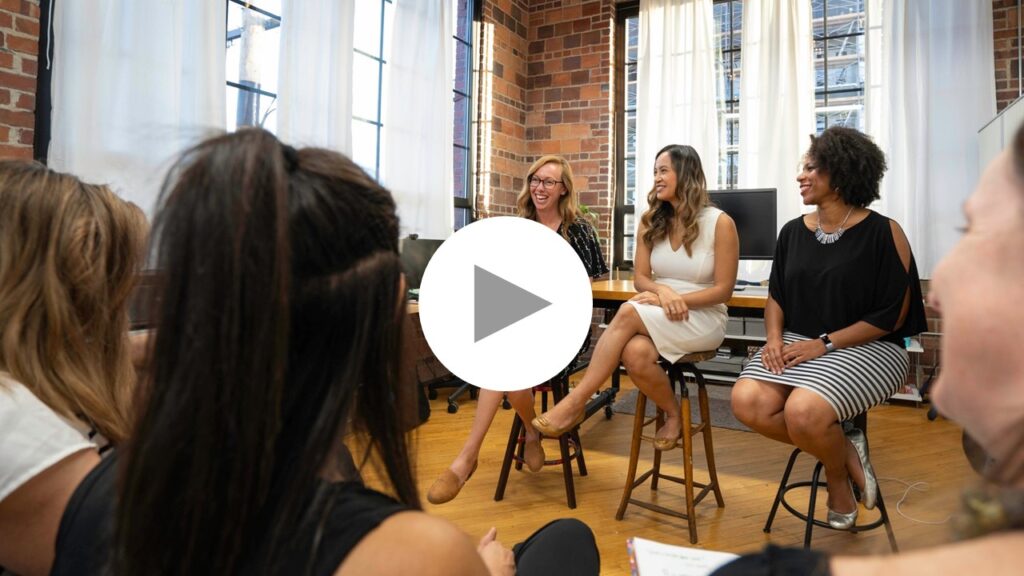RECOMMENDED VIDEO COURSE
PANEL DISCUSSION MASTERCLASS: FOR MODERATORS AND PANELISTS
Learn How to Moderate a Panel
Speaking in a panel discussion is challenging even for advanced presenters.
Moderating a panel discussion is significantly more challenging, and requires a much greater amount of work, foresight and preparation.
Effective moderation is a skill that can be learned and improved.
But above all, remember the critical importance of preparation and clear and frequent communication with your panelists.
Use these tips to make your panel discussion well-run, informative for the audience, and a rewarding experience for the panelists and organizers.
1. Be Amazing at Time Management
Be very realistic about time.
Lack of time awareness is one of the most common challenges I’ve seen new panel moderators make.

The time will go by much faster than you think.
Let’s say that you have 4 panelists, and one hour for your entire event from start to finish. That seems like plenty of time if everything goes perfectly.
Except in reality, things never go perfectly.
You might give a one-minute welcome and topic overview to the audience, plus 30 seconds to introduce each panelist. That’s 3 minutes.
Assume 10 minutes for Q&A.
But then, the event may start late (eating up 5 minutes once everyone is settled).
You may get an interruption from a technical problem or a disruptive audience member (another 4 minutes).
And one panelist may take too much time or go off on tangents (eating up a cumulative total of 5 extra minutes during the event).
So after all of these adjustments, your “core time” has gone down to 33 minutes. And that’s with an event that was supposed to be an hour long!
These estimates may be right in line with your expectations, or they may be a wakeup call.
Either way, making realistic plans based on your time constraints and the obligations you have as a moderator is critical for a successful panel discussion.
2. Assembling Your Panel
When learning how to moderate a panel, this backend preparation makes a huge difference.
The best panels have a diversity of voices with strong points of view on a significant topic of interest.

If you are in a position to select the speakers that will appear on your panel, then seek out people who have interesting perspectives and compelling credentials on the topic.
You may not be able to get all of the experts you would like, but even one recognizable name will generate buzz.
The ideal number of panelists for most events is between three and four.
Two panelists is too small (that is not really a “panel” but rather just a three-way conversation).
And five panelists will be too crowded.
Remember, you have to ensure that each panelist gets about equal time to contribute.
If you don’t consider one or several panelists to be as “significant” as others, then reconsider whether to include them in the first place.
3. Keep Your Questions Short, Sharp and Relevant
Nobody likes a long-winded panel moderator. Don’t be the moderator who drones on and on, and likes to hear themselves talk.
The audience is there to get the insights from the panelists, not to hear your personal opinions.
As the moderator, you have a tremendous amount of power. Don’t abuse it by blabbing excessively.
Develop targeted, concise and powerful questions that are highly relevant for your audience.
If you were in the audience, what would you like to ask each of the panelists?
If you are having a really hard time creating questions, you may be able to crowdsource your questions by emailing all attendees ahead of time and asking them what they want to know.
Example of How to Moderate a Panel with Good Questions
This moderator guides the discussion with periodic questions or prompts, without dominating the conversation:
4. Decide on Your Panel Discussion Format: Hot Potato vs Ping-Pong
There are other possible formats, but these two are the most common.
In the Hot Potato format, you pose a general question that every member of the panel is qualified to answer, and then each panelist answers one at a time.
In the Ping-Pong format, you ask a question to a specific panelist, they answer, and then the spotlight goes back to you.
You then ask a different question to the next panelist, and they respond, and so on.
The Ping-Pong is good when you have specific questions you’d like each panelist to answer, or you think the audience will benefit from curated, customized questions.
Whereas the Hot Potato is best suited to broad themes that you want each panelist to weigh in on.
The ideal panel discussion features a mix of both formats–some direct, targeted questions to individual panelists, and some general questions that solicit input from everyone.
Example of Panel Moderation Formats
This moderator uses both formats. In the first half of the video, she asks targeted questions to individual panelists (Ping-Pong).
And in the second half, she brings up general themes that she wants multiple panelists to speak about (Hot Potato):
5. Get Each Panelist’s Preferred Bio or Blurb
Get the bio (and/or company bio) from each panelist or their team.
You will still probably have to cut it down, (a) to fit it within your time limitations, and (b) to ensure each bio is about equal in length.
You don’t want to appear to favor one panelist at the expense of others by spending more time introducing them.
In rare occasions (usually with very big names whose career is public knowledge), you can create the bio yourself.
But in most cases, the panelists will have specific career milestones they will want to highlight, since this is probably a promotional or personal branding opportunity for them.
In the case of short events (say, 30 minutes), you may not give their bios at all, but rather just their names and titles/ affiliations.
6. Send the Questions and Topics in Advance
You want your panelists to be prepared and focused for your questions.
They will feel more comfortable in the live situation if they have had a chance to think about their answers.
And the audience will get a higher quality experience because the panelists’ answers will be higher quality.
You may be tempted to go “off-script” or surprise your panelists with “gotcha” questions, assuming that this will reveal their “true” thoughts or create an edgier experience for the audience.
Avoid that temptation. In reality, 90% of your potential speakers will be nervous going into the panel discussion, and probably have little or no experience with it.
Any surprises will make them more nervous. As a result, they will give safe, vanilla answers that will not add real value for the audience.
Or worse still, they will just punt, saying “that’s a great question, but I really can’t comment on that.” This makes you, as the moderator, seem out of touch with your own panel.
Only go “off-script” if you can tell the conversation is flowing really nicely and everyone on the panel seems relaxed and confident.

7. Familiarize Yourself with the Tech and Anticipate Problems
When we think about how to moderate a panel, we think a lot about the questions and overall format.
But we often neglect to familiarize ourselves with the technology we will be relying on.
This is a seemingly simple task, but one that makes a huge difference in everyone’s experience.
You need to take the time, on your own, to get comfortable with the tech. Especially for virtual/ remote panel discussions.
You can’t fully control what the panelists do.
But at least if you have knowledge of the tech, you’ll be able to smoothly handle technical issues or answer last-minute questions from your panelists.
Related to that, think through potential problems and how you will respond if they happen.
What if a panelist cancels last minute? What if there are no audience questions? What if the microphones suddenly fail?
8. If Possible, Do a Dry Run with the Panelists
This is not always possible given people’s schedules.
But if even a few of your panelists have time to practice and rehearse for just five minutes, it will make everything much smoother during the live event.
Have a list of items ready so you can go through them quickly and maximize everyone’s time:
Virtual Panel Discussions
- Go over the process of logging into the webinar if anyone is unfamiliar with it
- Make sure they all know how to turn their camera on, and give them tips on adequate lighting and minimizing background noise on their end
- Ensure everyone is muted when they are not speaking, to avoid background noise interfering when someone else has the floor
- Remind people to unmute themselves when they are called on, so they don’t start talking and nobody can hear them
- Go over the order that you will introduce them and what questions you will ask each of them
- Remind them of the total time for the event, and how you will run the Q&A portion
In Person Panel Discussions
- Go over their seating assignments so they know where to sit the minute they walk on stage
- Make sure everyone holds the microphone close to their mouth when speaking (or turns it on in the case of table mics)
- Go over the order you will introduce them, the questions you’ll ask, and the total time for the event
- Discuss the Q&A process: whether you will collect audience questions and ask them yourself, or allow for direct interaction between the panelists and audience members
9. Rehearse Your Intro and Questions
When students ask me how to moderate a panel, practice and rehearsal is a critical piece of advice I always give them.
Rehearsal is important for your delivery and clarity, as well as your time management during the panel discussion.
You don’t want your introduction, audience welcome, and panel bios at the beginning of the event to be the first time you’ve uttered those words.
Without prep time, you are liable to make mistakes or (most likely) run over time.
Rehearse all of your speaking portions, including how you will introduce the Q&A segment, and any final words of thank you to the audience at the end of the event.
There is also the “choreography” of speaking:
- Will you sit or stand? (I recommend sitting with your panel, but in some cases that may not be possible)
- Where will you place your notes?
- Will you have note cards? A sheet of paper? A tablet?
- Will you hold your notes in one hand and the microphone in the other?
- Make sure to look at both the panel and the audience as you are speaking
All of these movements should be rehearsed along with your verbal content.
10. Prep the Audience for Q&A and Have Backup Questions Ready
How to announce Q&A
Instead of suddenly launching into Q&A, announce to the audience “we will have time for audience questions in a few minutes, so please start getting your questions ready.” And then continue with the panel discussion for a few more topics.
You have probably attended events where the moderator solicits audience questions, and there’s a long pause of awkward silence.
This often happens because the audience was not prepared and didn’t have time to think about questions.
What if you open it up to Q&A, and the audience still has no questions?
It would be quite awkward if you haven’t prepared anything. Your backup or bonus questions will save the day.
You can simply smoothly continue the conversation with your panelists with your own extra topics.
Or alternatively, you can simply thank everyone and end the event early. Nobody will ever complain about an event that ended a few minutes early.
Question cards and digital Q&A
For in person panel discussions, you can have an assistant pass out cards and pens to the entire audience (or have the cards on their seats when they walk in).
Your colleague can collect those cards towards the end of the panel discussion, organize them, and then hand them to you.
This enables you to control which questions the panelists answer and also control the time. (But remember to plan and rehearse this whole process.)
If your event has the tech capabilities, you can also display audience questions live on the big screen with tools like Mentimeter and Slido.
And for virtual webinars over Zoom or other platforms, encourage the audience to submit questions in the chat box or Q&A button.
RECOMMENDED VIDEO COURSE
PANEL DISCUSSION MASTERCLASS: FOR MODERATORS AND PANELISTS
- You Are Who You Surround Yourself With: 6 Tactics to Build Your Network - December 15, 2021
- Executive Presence: 3 Keys to Communicate Leadership Qualities - December 10, 2021
- How to Think on Your Feet in Meetings and Presentations: 3 Mental Hacks - February 13, 2021

